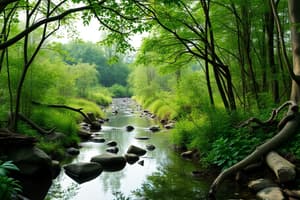Podcast
Questions and Answers
Which of the following best describes the role of decomposers in an ecosystem?
Which of the following best describes the role of decomposers in an ecosystem?
- They break down dead or decaying organisms. (correct)
- They produce food for primary consumers.
- They convert inorganic substances into organic matter.
- They compete with producers for sunlight.
Which of the following sequences accurately represents the flow of energy through an ecosystem from one trophic level to the next?
Which of the following sequences accurately represents the flow of energy through an ecosystem from one trophic level to the next?
- Secondary consumer → Primary consumer → Primary producer → Tertiary consumer
- Primary producer → Primary consumer → Secondary consumer → Tertiary consumer (correct)
- Primary producer → Secondary consumer → Primary consumer → Decomposer
- Primary producer → Primary consumer → Secondary consumer → Decomposer
In the context of a food web, what is the significance of secondary consumers?
In the context of a food web, what is the significance of secondary consumers?
- They directly produce energy through photosynthesis.
- They transfer energy from primary consumers to tertiary consumers. (correct)
- They are the primary source of energy for producers.
- They have a greater biomass than primary consumers.
What does the ecological pyramid illustrate about energy transfer?
What does the ecological pyramid illustrate about energy transfer?
Which statement best defines the term 'habitat'?
Which statement best defines the term 'habitat'?
How does the process of decomposition contribute to the carbon cycle?
How does the process of decomposition contribute to the carbon cycle?
Which is true regarding autotrophs in an ecosystem?
Which is true regarding autotrophs in an ecosystem?
What is the main component of the water cycle that follows evaporation?
What is the main component of the water cycle that follows evaporation?
In a typical ecological pyramid, how does biomass change as one moves up trophic levels?
In a typical ecological pyramid, how does biomass change as one moves up trophic levels?
What role do primary consumers play in the energy flow of an ecosystem?
What role do primary consumers play in the energy flow of an ecosystem?
Flashcards are hidden until you start studying
Study Notes
Abiotic and Biotic Features
- Abiotic features are non-living components that affect the environment, including sunlight, water, temperature, soil, air and nutrients.
- Biotic features are living components within an ecosystem, such as plants, animals, bacteria, fungi and microorganisms.
Key Terms
- Autotrophs are organisms that produce their own food from inorganic substances, like plants, algae, and certain bacteria.
- Heterotrophs consume other organisms for energy and nutrients, including animals, fungi and many bacteria.
- Producers are autotrophs that convert energy into usable forms, such as plants and phytoplankton.
- Consumers are heterotrophs that eat other organisms for energy, categorized as primary, secondary, and tertiary consumers.
- Decomposers break down dead or decaying organisms.
Ecosystem Terminology
- Habitat is the specific environment where an organism lives, encompassing both abiotic and biotic factors.
- Community refers to all the populations of species living and interacting within a particular area.
- Ecosystem encompasses a community of organisms interacting with their physical environment.
Energy Flow
- Food Chain depicts a linear sequence showing energy transfer between organisms.
- Food Web represents a complex network of interconnected food chains, illustrating multiple energy flow paths.
- Ecological Pyramid graphically illustrates energy distribution among trophic levels.
- Energy Pyramid shows that only 10% of energy is transferred from one trophic level to the next, with the remaining 90% lost as heat.
- Biomass Pyramid represents the total mass of organisms at each trophic level, typically decreasing due to energy loss.
Matter Cycling
- Water Cycle involves evaporation, condensation, precipitation, runoff and infiltration.
- Carbon Cycle includes photosynthesis, respiration, decomposition and combustion.
Studying That Suits You
Use AI to generate personalized quizzes and flashcards to suit your learning preferences.




